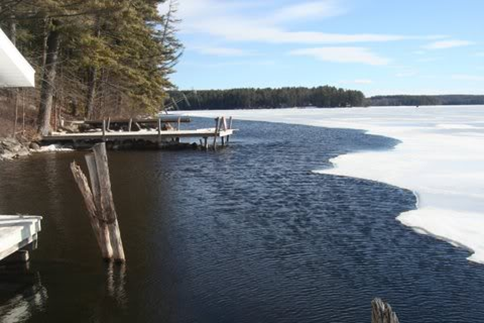Winter Ice Conditions
General Lake Ice Safety & Impact of Dock De-icers
A Letter of Caution and Concern from the SLPOA Board
Please be reminded that winter ice related recreational activities can be inherently dangerous. In recent weeks there have been troubling emergency rescues on neighboring Arbutus and Rennie Lakes due to recreationalists falling through the ice, with (thankfully) no deaths or overt injuries. Be especially aware that some Spider Lake riparians with permanent docks are using dock de-icers (bubbler, thrusters, or agitators) to protect their dock investments from possible ice damage. It has become apparent that improper application and/or operation of de-icers can cause extensive areas of open water and thin hazardous ice well beyond the intended area of dock protection, including several hundred feet along neighbors’ shorelines and 50-200 feet into the main body of the lake. Our lake is used day and night during fair and inclement weather, by adults as well as children, for winter sports including ice skating, XC skiing, snowshoeing, ice fishing, snowmobiling, etc. Poor visibility, especially at night, during fog, or blowing snow makes detection of unexpected areas of hazardously thin ice and open water especially dangerous.
Health, Welfare, & Safety of Resident Community - SLPOA's Utmost Concerns
Because one of SLPOA’s bylaws states, “to be on guard for the health, welfare and safety of our resident community”, we urge the following:
Extreme caution should be exercised by all on the ice throughout the winter, especially around areas that have permanent docks even if the ice appears sound. There may be docks with de-icers that are inapparent and which we and riparian neighbors may be unaware.
If you have decided to use a de-icer around your dock, please be cognizant of the safety hazard with risk for injury to persons, pets, and wildlife, along with the liability involved.
Protecting through Education - A Key SLPOA Objective
Another SLPOA objective is to “preserve Spider Lake as a natural resource and recreational area through protection and prudent use of its resources”. With that in mind and with a focus on education, we wish to share the following established adverse impacts of lake de-icers:
De-icers disrupt intact lake ice which has important beneficial environmental effects for lake ecosystem health, including the annual turnover that occurs in spring and late fall that is important for nutrient and phosphorus distribution, as well as oxygenation.
Use of such dock protection may contribute to earlier lake warming in the spring, which may increase the risk of harmful toxic algal blooms.
Disruption of bottomland sediments may increase nutrient release, such as phosphorus that will result in additional algae.
There may be negative impact on the normal microbial and zooplankton cycles that can negatively affect feeding habits of fish and other aquatic organisms.
Example of bad practice
Dock de-icer creating a large patch of open water; dangerous for recreation *
Example of better practice
Dock de-icer creating only small patch of open water.*
The Law
As riparians on inland lakes, we own the bottomlands associated with our properties, but by Michigan law the water (and therefore surface lake ice) is held in public trust, and we are prohibited from activities that prevent safe navigation by recreationalists, and lawful access by the public in all seasons.
If you currently have a permanent dock, are considering one, or a rebuild, please consider instead installing a seasonal dock. Benefits include: environmental benefits to lake ecology, decreased danger, and no need for a bubbler/de-icer with its associated expenses and liability.
Suggestions for Safer, Efficient Use of De-Icers
Please seriously reconsider if winter dock protection is necessary, as it may not be needed in shallow water, protected coves and on leeward shores without much wind exposure.
If you use a winter dock de-icer, please:
Limit its effects to your dock’s immediate area and not more than a few feet beyond the pilings.
Use a timer set to 2-4 hours per day, and a thermostatic control set to run only when temperatures are below freezing.
Assess the de-icer’s effects throughout the winter.
Assure that the shoreline effects do not prevent safe access to the lake for yours and your neighbors’ family and guests.
Realize that improperly installed and mismanaged de-icers can create large areas of open water that may actually increase the risk of damage to docks by giving ice floes room to accelerate with wind and waves.
Post large signage visible for at least 150 feet from the dock and your shoreline warning of the hazard.
Thin Ice Warning Sign
Example of signage for dock with de-icer
Additional Information may be found at these links
*Detailed de-icer and dock tips - https://www.lakesunapee.org/dock-deicers - Photos from here
Michigan DNR Ice Safety Guide - https://www.michigan.gov/dnr/education/safety-info/ice
MSU Extension Ice Safety Tips - https://www.canr.msu.edu/news/ice_safety_tips_selden18
"Ice, Wind, & Rain" webinar with - https://www.youtube.com/watch?v=2HlLjWnCfeI
February 2024 SLPOA distribution by SLPOA ENEWS and by USPS for property owners without shared email addresses



